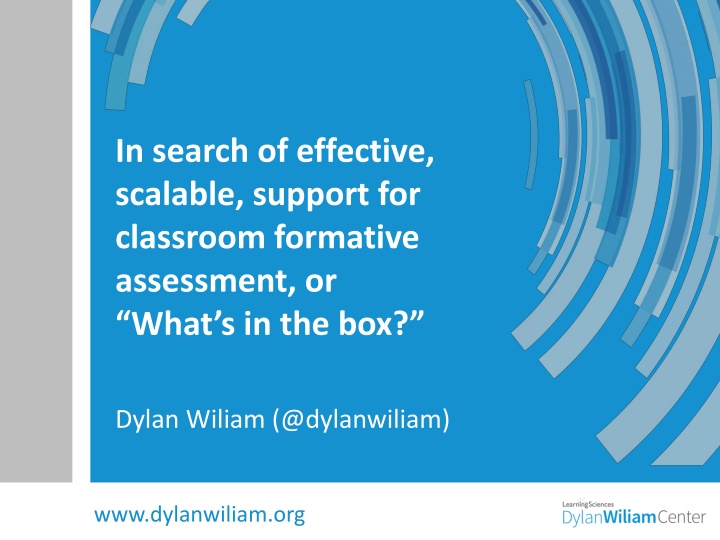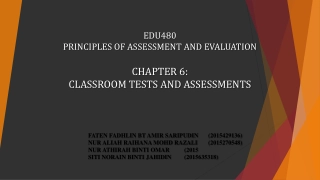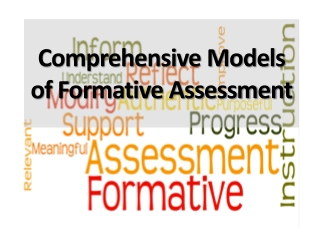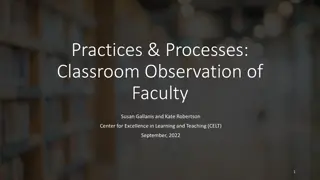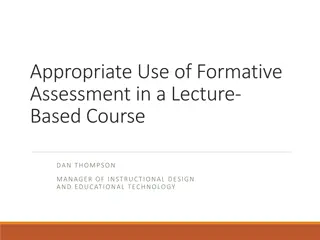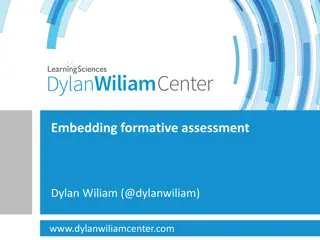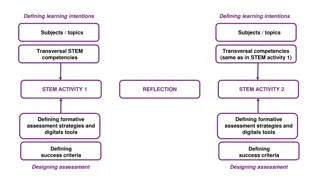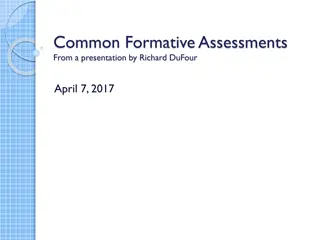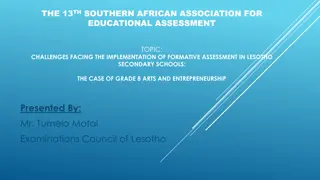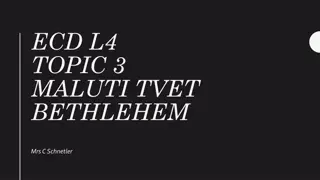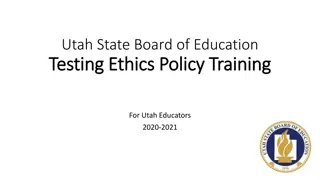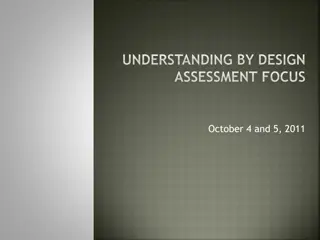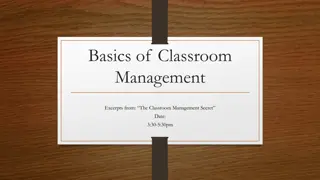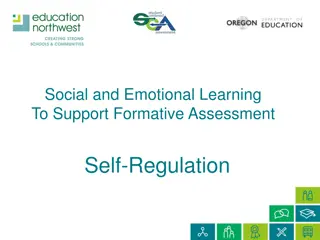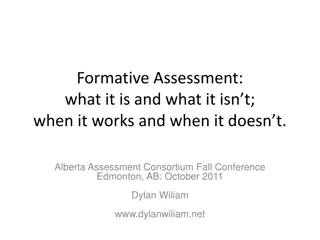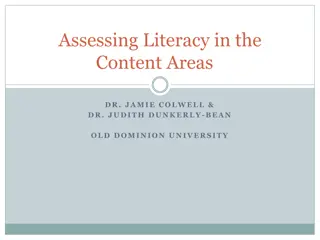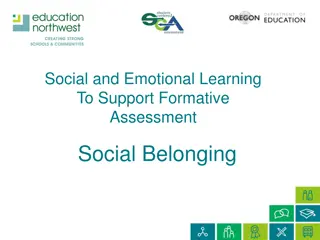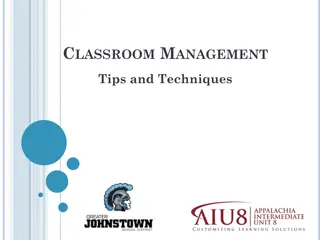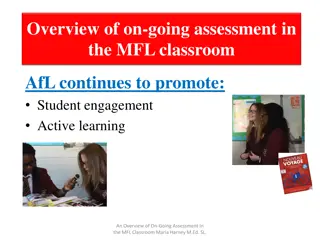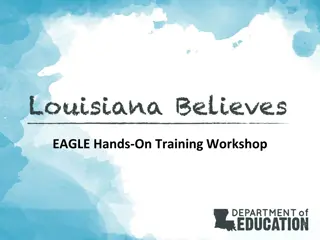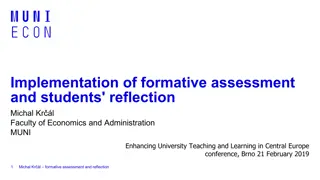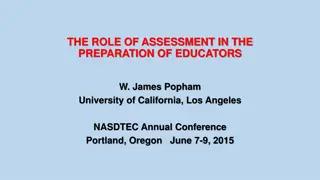Effective Classroom Formative Assessment Insights
This insightful content delves into Dylan Wiliam's work on scalable support for formative assessment in classrooms. It explores the importance of understanding what learners already know, the empirical evidence supporting formative assessment, and the various aspects and controversies surrounding this crucial educational practice.
Download Presentation

Please find below an Image/Link to download the presentation.
The content on the website is provided AS IS for your information and personal use only. It may not be sold, licensed, or shared on other websites without obtaining consent from the author.If you encounter any issues during the download, it is possible that the publisher has removed the file from their server.
You are allowed to download the files provided on this website for personal or commercial use, subject to the condition that they are used lawfully. All files are the property of their respective owners.
The content on the website is provided AS IS for your information and personal use only. It may not be sold, licensed, or shared on other websites without obtaining consent from the author.
E N D
Presentation Transcript
In search of effective, scalable, support for classroom formative assessment, or What s in the box? Dylan Wiliam (@dylanwiliam) www.dylanwiliam.org
A (suspiciously neat) retrospective 2 Five phases 1. 1992-1997: Reviewing the evidence 2. 1998-2003: Working with teachers on implementation 3. 2004-2009: Work on scalability 4. 2010-2015: Working with leaders 5. 2016-2021: Creating conditions for system transformation
Formative assessment: The intuitive case 3 A principle and an uncomfortable fact about the world The principle: If I had to reduce all of educational psychology to just one principle, I would say this: The most important single factor influencing learning is what the learner already knows. Ascertain this and teach him [or her] accordingly. (Ausubel, 1968 p. vi) The uncomfortable fact: Students do not learn what we teach. What is learning? Learning is a change in long-term memory (Kirschner et al., 2006) The fact that someone can do something now does not mean they will be able to do it in six weeks, but If they cannot do something now, it is highly unlikely they will be able to do it in six weeks
Formative assessment: The empirical case 4 Fuchs & Fuchs (1986) Natriello (1987) Crooks (1988) Bangert-Drowns et al. (1991) Dempster (1991, 1992) Elshout-Mohr (1994) Kluger & DeNisi (1996) Black & Wiliam (1998) Nyquist (2003) Allal & Lopez (2005) K ller (2005) Brookhart (2007) Wiliam (2007) Hattie & Timperley (2007) Shute (2008) Kingston & Nash (2011, 2015)
Formative Assessment: A contested term 5 Long-cycle Medium-cycle Short-cycle Within and between teaching units Within and between lessons Across terms, teaching units Span Minute-by- minute and day-by-day Four weeks to one year One to four weeks Length Monitoring, curriculum alignment Student- involved assessment Engagement, responsiveness Impact
Unpacking Formative Assessment 6 Where the learner is going Where the learner is now How to get the learner there Providing feedback that moves learners forward Eliciting evidence of learning Teacher Clarifying, sharing, and understanding learning intentions Activating students as learning resources for one another Peer Activating students as owners of their own learning Student
7 The relationship of formative assessment to other policy priorities
Educational Endowment Foundation toolkit 8 Intervention Cost Quality of evidence Extra months of learning Feedback $$ +8 Metacognition and self-regulation $$ +8 Peer tutoring $$ +6 Early years intervention $$$$$ +6 One to one tuition $$$$ +5 Homework (secondary) $ +5 Collaborative learning $ +5 Phonics $ +4 Small group tuition $$$ +4 Behaviour interventions $$$ +4 Digital technology $$$$ +4 Social and emotional learning $ +4
Educational Endowment Foundation toolkit 9 Intervention Cost Quality of evidence Extra months of learning Parental involvement $$$ +3 Reducing class size $$$$$ +3 Summer schools $$$ +3 Sports participation $$$ +2 Arts participation $$ +2 Extended school time $$$ +2 Individualized instruction $ +2 After school programmes $$$$ +2 Learning styles $ +2 Mentoring $$$ +1 Homework (primary) $ +1
Educational Endowment Foundation toolkit 10 Intervention Cost Quality of evidence Extra months of learning Teaching assistants $$$$ 0 Performance pay $$ 0 Aspiration interventions $$$ 0 Block scheduling $ 0 School uniform $ 0 Physical environment $$ 0 Ability grouping $ -1 Education Endowment Foundation (2014)
Unpacking Formative Assessment 11 Where the learner is going Where the learner is now How to get the learner there Providing feedback that moves learners forward Eliciting evidence of learning Teacher Clarifying, sharing, and understanding learning intentions Activating students as resources for one another Peer Activating students as owners of their own learning Student
Empirical evidence 12 Domain- specific mixed general Kingston and Nash (2011, 2015) 0.20 Wiliam et al. (2004) 0.32 Andrade et al. (2019) 0.26 Burkhardt and Schoenfeld (2019) 0.13
Designing for scale In-principle scalability A single model for a whole school Formative assessment as both generic and domain-specific Understanding what it means to scale (Coburn, 2003) Depth Sustainability Spread Shift in reform ownership Consideration of the diversity of contexts of application Clarity about components, and the theory of action
Embedding Formative Assessment 15 Whole-school turnkey 2-year PD program Focus on five strategies of formative assessment Detailed resource packs for groups of 8 - 14 teachers 18 monthly 75-minute meetings Peer observations between meetings Cost Additional expenditure: Teacher commitment: $2 per student per year 1% of contracted time
A signature pedagogy for teacher learning 16 Every monthly teacher learning community meeting follows the same structure: Activity 1: Introduction (5 minutes) Activity 2: Starter activity (5 minutes) Activity 3: Feedback (25 50 minutes) Activity 4: New learning about formative assessment (20 40 minutes) Activity 5: Personal action planning (15 minutes) Activity 6: Review of learning (5 minutes)
School-based, non-expert, TLC leaders 17 The job of the TLC leader(s): To ensure that all necessary resources (including refreshments!) are available at meetings To ensure that the agenda is followed To maintain a collegial and supportive environment But most important of all: It is not to be the formative assessment expert.
Peer observation 18 Run to the agenda of the observed, not the observer: Observed teacher specifies focus of observation: E.g., teacher wants to increase wait time. Observed teacher specifies what counts as evidence: Provides observer with a stopwatch to log wait times. Observed teacher owns any notes made during the observation.
Take-up England acquired by ~40% of all secondary schools Scotland in use in all but one of Scotland s 32 school districts Singapore used in 75% of all elementary schools Australia Adopted as a state-wide model in South Australia
Evaluation 20 Intention to treat pre-registered design Participants Power: 80% chance to detect an effect size of 0.2 140 schools recruited (70 treatment, 70 control) Excluding those with previous involvement in similar work 58 treatment, 66 control 22,709 students in year 10 in Sep 2015 Outcome measure Attainment 8 Average score on exams in 8 subjects taken in May 2017
English literature (Macbeth) Read the following extract from Act 1 Scene 5 of Macbeth and then answer the question that follows. At this point in the play Lady Macbeth is speaking. She has just received the news that King Duncan will be spending the night at her castle.
Question (45 minutes) Starting with this speech, explain how far you think Shakespeare presents Lady Macbeth as a powerful woman. Write about: how Shakespeare presents Lady Macbeth in this speech how Shakespeare presents Lady Macbeth in the play as a whole Assessment and Qualifications Alliance (2014)
History Pearson (2015)
Estimating annual growth for 15-16 year olds Source Data Age Growth (SDs) Bloom et al (2008) US standardized tests 15 0.20 Rodriguez (2006) TIMSS 14 0.36 OECD (2016) PISA 15 0.30 NAEP (2018) NAEP 14 0.25 Assumed annual growth: 0.3 standard deviations per year
Impact on student achievement 25 One year s learning for 15 year olds One year s learning for 15 year olds One year s learning for 15 year olds One year s learning for 15 year olds One year s learning for 15 year olds 0.3 sd 0.3 sd 0.3 sd 0.3 sd 0.3 sd Attrition of learning per year Attrition of learning per year Attrition of learning per year Attrition of learning per year 0.1 0.1 0.1 0.1 Expected progress for control group students in two years: students in two years: students in two years: Expected progress for control group Expected progress for control group 0.3*0.9 + 0.3*5/6 = 0.52 sd = 0.52 sd = 0.52 sd 0.3*0.9 + 0.3*5/6 0.3*0.9 + 0.3*5/6 Effect size on examinations (8 subjects) for those who had not previously participated those who had not previously participated Effect size on examinations (8 subjects) for 0.13 0.13 Increase in rate of learning = 0.13/0.52 = 0.25 Speckesser, Runge, Foliano, Bursnall, Hudson-Sharpe, Rolfe, and Anders (2018)
